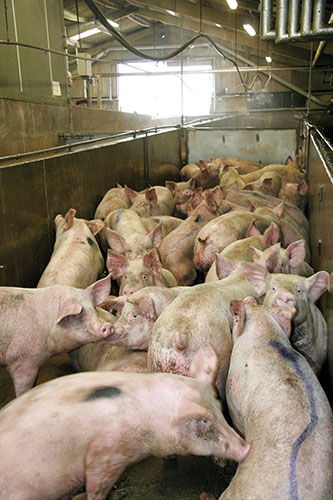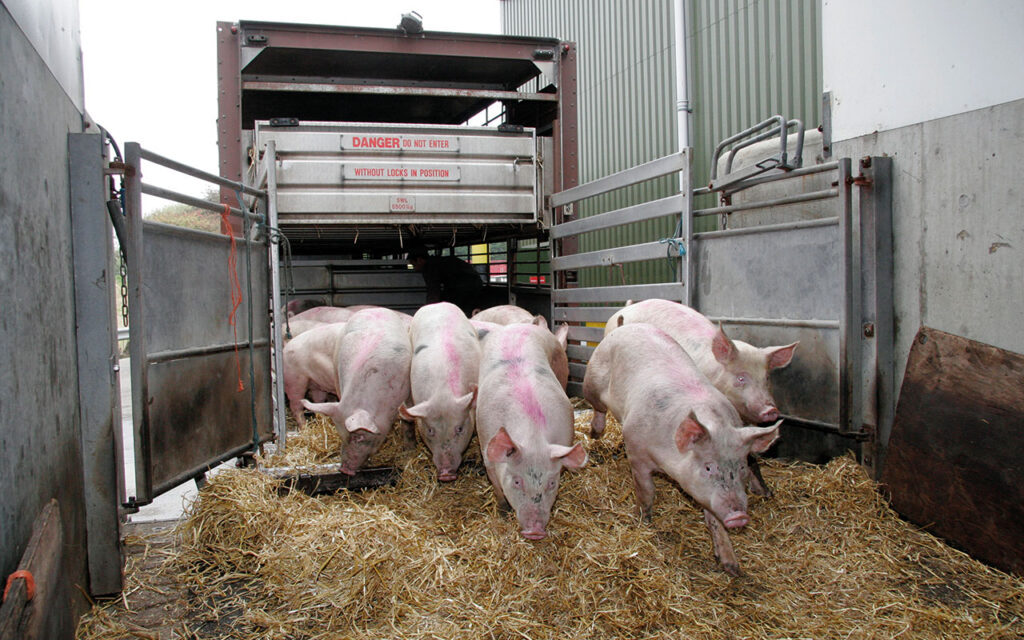Questions that have been rumbling for a long time over the use of carbon dioxide to stun pigs in UK abattoirs have just got louder.
The Animal Welfare Committee’s (AWC) recommendation that CO2 should be phased out, with a transition to alternative methods within five years, alongside a possible slowing of slaughter lines, has upped the ante and left the industry with a fine line to tread.
While, given the concerns about CO2, the commitment remains within the sector to continue the search for workable alternatives, the reality is that none are currently close to being available. CO2 remains the best option at a commercial level. There is a real fear, therefore, that if the UK moves too far, too fast, there could be serious unintended consequences for pig welfare, pig businesses and the UK’s food security.
According to a 2024 Food Standards Agency survey, 90% of pigs reared in England and Wales are stunned in abattoirs by exposure to high-concentration CO2 using controlled atmosphere stunning (CAS) systems.
The remaining 10% are stunned using manual head-only or head-to-body electrical stunning or, for a very small number, percussive stunning with a penetrative captive bolt device.
The Farm Animal Welfare Council in 2003, and the European Food Safety Authority in 2004 and 2020, have previously recommended that high-concentration CO2 gas mixes should be phased out in abattoirs because the practice is ‘known to be aversive to pigs’.
In November 2024, the government commissioned the AWC to provide a comprehensive animal welfare assessment of the current evidence on high-concentration CO2 stunning of pigs and the potential alternative methods. Its opinion was published in October.
Animal Welfare Committee
AWC is an independent expert committee of Defra and the devolved administrations, advising on animal welfare, ‘based on scientific research, stakeholder consultation and experience’.
Chaired by Madeleine Campbell, professor of veterinary ethics at Nottingham University, it has 14 members from a range of relevant backgrounds.
Controlled atmosphere stunning
The CAS system is designed to enable groups of five to seven pigs to be restrained within a cage, or ‘gondola’, which is introduced quickly to a high concentration of CO2.
Three to six gondolas operate on a motorised loop, which lowers them into and out of a pit. CO2 is continually pumped into the base of the pit to maintain the necessary gas concentration throughout.
The pigs experience a gradual loss of consciousness and an ‘irreversible stun’ when exposed to high concentrations of the gas.
“Loss of posture is commonly used as a proxy for unconsciousness. After this, they continue to show reflex behaviours such as hyperventilation [gasping] and convulsions, but these are not consciously experienced and are understood to be non-relevant to welfare assessment,” the report explained.
The report concludes, however, that exposure of conscious pigs to high concentrations of CO2 is associated with three major welfare concerns: pain, respiratory distress and fear.
“These manifest behaviourally as vocalisations, hyperventilation and escape attempts. These are observed before loss of posture and hence occur in the conscious phase of the stunning process,” it said.
Inhalation of high-concentration CO2 is painful because the gas dissolves in the mucous membranes of the eyes, nose, mouth and lungs to form carbonic acid, the report said, noting that pain severity is likely to be high at current concentrations.
It is associated with fear and anxiety due to ‘exposure to novel stimuli, respiratory distress and experiencing a highly aversive yet inescapable environment’, the report added.

Alternatives
The committee acknowledged that a lack of viable alternative stunning methods for commercial throughputs ‘has helped to maintain the status quo’ regarding CO2 stunning.
Its report takes a detailed look into the viability of other methods, including exposure to an inert gas mix.
Argon: AWC concluded that, of the inert gases assessed in the ongoing EU PigStun project that is testing alternatives to CO2, argon is ‘the most suitable alternative for commercial use at this time, taking all factors into consideration’.
The report said immersion in argon ‘causes minimal immediate visible reaction, since these gases cannot be sensed directly by the pig’, and cites research suggesting that ‘pigs do not find inhalation of inert gases immediately aversive’.
“However, the induction of unconsciousness remains gradual, and it should be noted that all lethal CAS mixes are associated with some degree of welfare compromise,” the report said.
The PigStun project found that inert gases require 40% longer exposure time than high-concentration CO2. Noting that in GB, unlike in the EU and elsewhere, pigs are required to emerge dead from the gas system, AWC warned that inadequate ‘dwell’ time could result in an ‘incomplete stun’.
It noted that while there are ‘technical challenges’ to using inert gases in current CO2 systems, argon is heavier than air, so it can be used in existing structures with the appropriate modifications to sensors.
However, although the EU PigStun project predicts that retrofitting an argon system into a CO2 facility should only take ‘one to two days’, this has not been proven in practice. Other considerations such as manufacturing time, sourcing of gas, training and developing standard operating procedures also need to be considered, the report cautioned.
It concluded that there is no welfare benefit of adding CO2 to inert gases.
Nitrogen and helium: Government-commissioned research into pigs exposed to a mix of 85% nitrogen and 15% CO2 for at least 90 seconds found that this was more aversive to pigs than 90% argon in atmospheric air.
Helium is less aversive than CO2, however, with little or no reaction before loss of consciousness, and is considered safe for operatives. However, a small-scale system devised as part of PigStun again showed it takes longer for pigs to be stunned than with high-concentration CO2.
Given that it is much lighter than air, a helium system would require significant investment in a raised tower system, raising questions about its feasibility in commercial settings.
Electrical stunning: Electrical stunning causes a near-instantaneous loss of consciousness, which in head-only stunned pigs is ‘transient and reversible’ and in head-to-body stunning, applied across both the brain and chest, functions as a stun-to-kill method.
AWC found the potential for welfare issues, including risk of inadequate stunning due to incorrect electrode placement when done manually.
The requirement to reduce pigs from groups to single file in semi- and fully- automated stunning systems can cause stress, with pigs often reluctant to move forward, necessitating the use of movement aids such as paddles and electric prods, which can cause additional pain and distress.
Captive bolt devices: Penetrating captive bolt devices tend to be employed as back-up stunning methods. When correctly applied, they can be an effective method to induce rapid unconsciousness. However, several animal welfare issues can arise if it is incorrectly applied, AWC noted.
Meat quality
The PigStun Project assessed meat quality in four different stunning systems. None of the stun methods performed better in this regard than when animals were stunned with CO2 alone.
The large number of variables between the four different stun systems meant that no statistical analysis of meat quality levels could be made. However, there was ‘little indication that meat quality would not be acceptable from a commercial setting’.

Recommendations
AWC makes a number of recommendations to government and industry, including:
- The use of CO2, including in combination with inert gases, as a method of stunning for pigs should be prohibited to prevent pigs experiencing avoidable pain, distress or suffering at slaughter associated with high concentrations.
- Any transition period given to industry to change to alternative methods should be as short as possible and ‘in any case within five years’.
- Operators who convert to commercial inert gas stunning systems must ensure calibration of their equipment, based on the size, age and category of pigs, to ensure animals remain in the gas for the duration necessary to achieve irrecoverable unconsciousness.
- Slaughter lines should be approved to slaughter no more than a specified number of animals per hour, such that each animal has time to move through the system without the need for physical coercion.
- Legislation should be amended to require pigs to be kept in a small social group, preferably with animals from their rearing group, during lairaging and slaughter.
- Government and industry should encourage research into technologies, such as automated video monitoring systems, to assess animal welfare in animal handling, stunning and slaughter processes in the abattoir.
Defra response
The government is not bound by the AWC’s recommendations and will make up its own mind how to proceed, no doubt taking into account views on both sides of the debate.
It has long made it clear, however, that it recognises the ‘long-standing animal welfare concerns’ over the use of CO2 in abattoirs and is ‘actively looking at alternative approaches’. This report would appear to give it a platform to work from.
A Defra spokesperson said: “This government wants to see the highest possible standards of animal welfare at slaughter. We are now carefully considering the findings of this report.”
Industry reaction
Meat industry bodies responded by mounting a strong defence of CO2 as the best option currently available by a distance.
Dr Jason Aldiss, the Association of Independent Meat Suppliers’ (AIMS) executive director, said: “The AWC’s recommendation would replace a proven, welfare-led system with one that is untested in practice and, in trials, shows poorer outcomes.”
AIMS said the document misrepresents the realities of modern slaughter systems and risks reversing decades of welfare progress.
“Under current UK practice, pigs are handled calmly in small social groups and moved quietly through a CO2 chamber, where they lose consciousness rapidly and without restraint,” it said.
“The process is continuously monitored by trained staff and veterinary professionals and operates under some of the strictest welfare legislation anywhere in the world. This approach is recognised internationally as the most humane, consistent and scalable stunning method available.
“By contrast, other methods result in higher stress and variable reliability; electrical stunning requires individual handling, and argon-based stunning necessitates longer exposure times, both of which can compromise welfare.”
AIMS said the report lacked practical detail on how any transition to alternative methods could be achieved safely or effectively, and fails to address key operational realities such as plant design, gas supply, staff safety and handling challenges in commercial abattoirs.
AIMS reaffirmed its support of ongoing research to refine existing CO2 systems, but said ‘change must be driven by science, not ideology’.
Nick Allen, chief executive of the British Meat Processors Association, said the structural changes to plants that would be needed to transition to alternative systems would be difficult to achieve within the five-year timeframe.
“As the report acknowledges, there is currently no commercially tested inert gas alternative to CO2 that has been trialled, licensed and is ready to implement,” he said.
“Additionally, the animal welfare issues associated with the other suggested alternatives would prove worse than the current system, putting more stress, not less, onto animals.”
Pointing out that no other country has gone down this route, he said moving away from CO2 would slow down operations to such an extent that it would render processors completely uncompetitive in the global market.
“It would decimate the domestic pigmeat industry and deliver a severe blow to UK food security,” he said.
NPA chief executive Lizzie Wilson said the association acknowledges concerns that the slaughter of pigs ‘could and should be more humane’, and was part of a UK pig sector group committed to exploring alternatives.
“But any new approach must be commercially viable, to ensure uptake and quality of meat, and to prevent any unintended consequences for welfare – for example, throughput capacity must be sufficient to ensure that pigs are not held on farm or in lairage for longer than necessary.”
She stressed that there is still no conclusive ‘best’ alternative due to issues with throughput capacity, meat quality and cost. “The UK pig industry must now work together to decide how we go forward,” she said.
Practical phase
However, organisations that have long been pushing for CO2 to be outlawed in abattoirs welcomed the recommendations.
An RSPCA Assured spokesperson said: “We urge the government to implement a practical phase-out that improves pig welfare, while giving the farming community a clear roadmap and the support they need to make the transition successfully.”
Dr Huw Golledge, CEO of the Humane Slaughter Association, said: “The evidence has long been clear that CO2 is not humane, and there are now more humane and practical alternatives available.
“We urge the government to act swiftly on the report’s findings and set a phase-out period of no more than five years, which is an achievable timeframe for industry to solve any remaining practical challenges.
“Ahead of any government action, we would encourage the pig industry to begin working in earnest towards implementing humane alternatives.”




